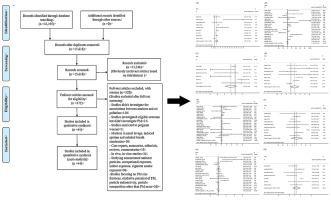Environmental Pollution ( IF 7.6 ) Pub Date : 2020-09-10 , DOI: 10.1016/j.envpol.2020.115630 Hong Tang 1 , Zilu Cheng 2 , Na Li 1 , Shuyuan Mao 1 , Runxue Ma 3 , Haijun He 3 , Zhiping Niu 1 , Xiaolu Chen 1 , Hao Xiang 1

|
Inflammation and the coagulation cascade are considered to be the potential mechanisms of ambient particulate matter (PM) exposure-induced adverse cardiovascular events. Tumor necrosis factor-alpha (TNF-α), interleukin-6 (IL-6), interleukin-8 (IL-8), and fibrinogen are arguably the four most commonly assayed markers to reflect the relationships of PM with inflammation and blood coagulation. This review summarized and quantitatively analyzed the existing studies reporting short- and long-term associations of PM2.5(PM with an aerodynamic diameter ≤2.5 μm)/PM10 (PM with an aerodynamic diameter≤10 μm) with important inflammation and blood coagulation markers (TNF-α, IL-6, IL-8, fibrinogen). We reviewed relevant studies published up to July 2020, using three English databases (PubMed, Web of Science, Embase) and two Chinese databases (Wang-Fang, China National Knowledge Infrastructure). The OHAT tool, with some modification, was applied to evaluate risk of bias. Meta-analyses were conducted with random-effects models for calculating the pooled estimate of markers. To assess the potential effect modifiers and the source of heterogeneity, we conducted subgroup analyses and meta-regression analyses where appropriate. The assessment and correction of publication bias were based on Begg’s and Egger’s test and “trim-and-fill” analysis. We identified 44 eligible studies. For short-term PM exposure, the percent change of a 10 μg/m3 PM2.5 increase on TNF-α and fibrinogen was 3.51% (95% confidence interval (CI): 1.21%, 5.81%) and 0.54% (95% confidence interval (CI): 0.21%, 0.86%) respectively. We also found a significant short-term association between PM10 and fibrinogen (percent change = 0.17%, 95% CI: 0.04%, 0.29%). Overall analysis showed that long-term associations of fibrinogen with PM2.5 and PM10 were not significant. Subgroup analysis showed that long-term associations of fibrinogen with PM2.5 and PM10 were significant only found in studies conducted in Asia. Our findings support significant short-term associations of PM with TNF-α and fibrinogen. Future epidemiological studies should address the role long-term PM exposure plays in inflammation and blood coagulation markers level change.











































 京公网安备 11010802027423号
京公网安备 11010802027423号